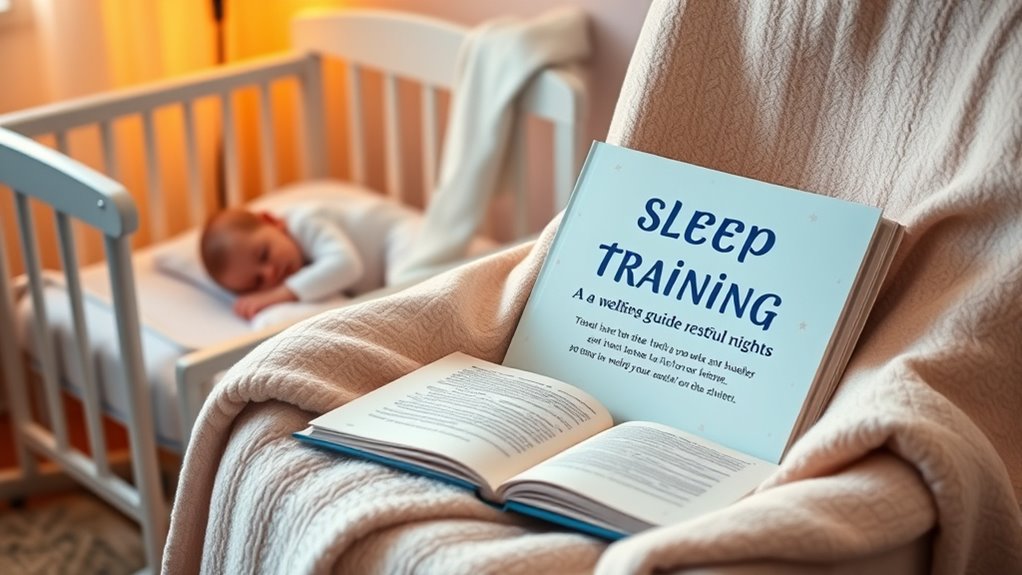If you’re looking for the best child sleep training books, I recommend ones that combine gentle, science-based techniques with practical routines. Some top choices include books focused on establishing bedtime rituals, addressing specific needs like twins, and guiding parents through effective methods without stress or crying it out. These resources offer clear steps, relatable stories, and helpful tips to make nights calmer for everyone. Keep exploring further to discover how these books can help your little one sleep peacefully.
Key Takeaways
- Many books offer gentle, evidence-based sleep training methods suitable for infants and young children.
- Resources include colorful storybooks and routines that make bedtime enjoyable and establish healthy habits.
- Some titles provide practical, parent-driven strategies to reduce night wakings and promote independent sleep.
- Specialized guides address unique needs like twins, sleep regressions, or children with special challenges.
- These books often combine expert advice with relatable stories to help children sleep through the night peacefully.
The Little Book of Bedtime Children’s Book About Sleep and Bedtime Routine

If you’re looking for a children’s book that makes bedtime routines both fun and educational, “The Little Book of Bedtime” is an excellent choice for kids aged 3-10. I’ve found it effective in helping children understand why sleep matters and how to establish a calming routine. Its bright, colorful illustrations captivate kids, encouraging engagement. The book introduces a simple 5-step routine and explains the benefits of good sleep in an age-appropriate way. Parents and caregivers report that it makes bedtime more enjoyable and helps children develop healthy sleep habits. Overall, it’s a valuable tool for fostering positive attitudes toward sleep from an early age.
Best For: parents, caregivers, and educators seeking a colorful, engaging, and educational bedtime story to help children aged 3-10 develop healthy sleep habits and routines.
Pros:
- Bright, colorful illustrations that captivate children and enhance engagement
- Effectively explains the importance of sleep and establishes a simple 5-step bedtime routine
- Suitable for a wide age range, making it versatile for different developmental stages
Cons:
- Some copies may have quality issues, such as pages from different books mixed in
- Higher price point compared to other children’s books, which may be a consideration
- As part of a series, the quality and content might vary between editions or volumes
The Helping Babies Sleep Method

The Helping Babies Sleep Method is an excellent choice for parents seeking gentle, science-based sleep training strategies that can be tailored to their comfort level. I’ve seen firsthand how Sarah Mitchell’s approach transforms restless nights into peaceful sleep. Many parents, overwhelmed by conflicting advice, find her clear, step-by-step guidance a game-changer. Her methods help babies sleep 11+ hours, settle independently, and enjoy consistent naps. What I love is how flexible and compassionate her techniques are—parents can choose a gentle stay-in-room approach or controlled checks. This method not only restores sleep but also boosts parental confidence, making bedtime routines calmer and more manageable.
Best For: parents seeking gentle, evidence-based sleep training strategies that can be customized to their comfort level and their baby’s needs.
Pros:
- Clear, step-by-step instructions that are easy to follow and adapt.
- Combines scientific understanding with gentle, flexible techniques.
- Helps babies sleep 11+ hours, settle independently, and improves family well-being.
Cons:
- Some reviewers note minor typos or formatting issues in the book.
- Requires parental consistency and patience to see full results.
- May not be suitable for parents seeking strict “cry it out” methods.
Sleep Training Guide for Babies, Kids, and Parents
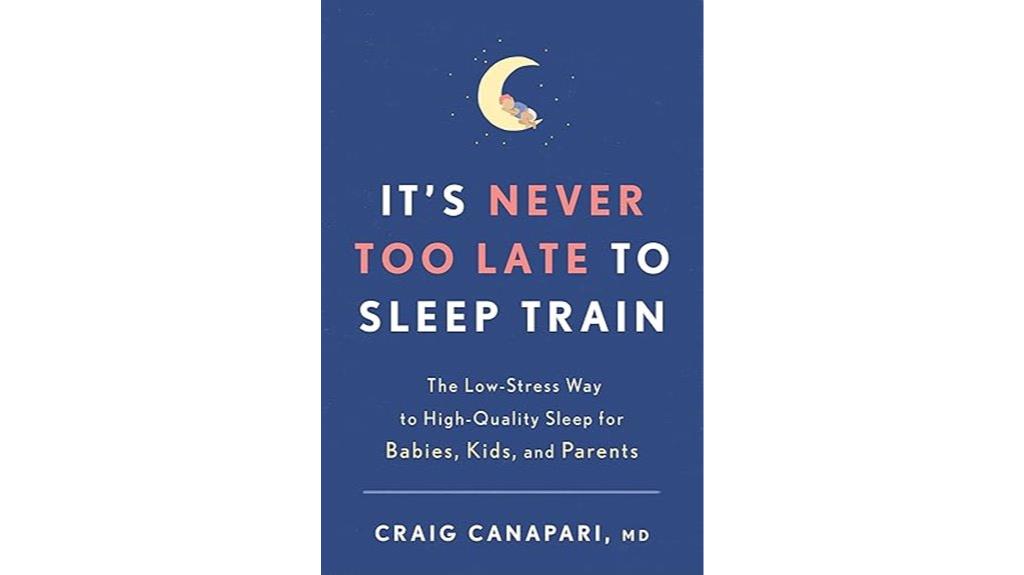
Looking for a sleep training book that truly understands the challenges modern parents face? Dr. Canapari’s guide is a game-changer. As Yale’s Pediatric Sleep Center director, he combines expert advice with real-world parenting insights. His approachable, humorous tone makes complex sleep science easy to grasp, offering flexible strategies for babies through school-age children, including those with special needs. Parents report quick results—sometimes in just three nights—by following his practical, evidence-based techniques. The book’s clear structure, relatable tone, and actionable tips make it a trustworthy resource for any parent tired of sleepless nights and seeking effective, compassionate solutions.
Best For: parents seeking practical, evidence-based sleep strategies for children of all ages, including those with developmental challenges, who want compassionate and flexible guidance.
Pros:
- Clear, well-organized advice tailored to different age groups and family situations
- Humorous, relatable tone that makes complex sleep science accessible and reassuring
- Rapid results reported by many parents, sometimes within just three nights
Cons:
- Some parents may prefer more structured or intensive sleep training methods
- The book may not cover every unique sleep challenge or medical concern in detail
- As it covers a broad age range, some readers might find certain sections less relevant to their specific needs
Healthy Sleep Habits, Happy Child, 5th Edition
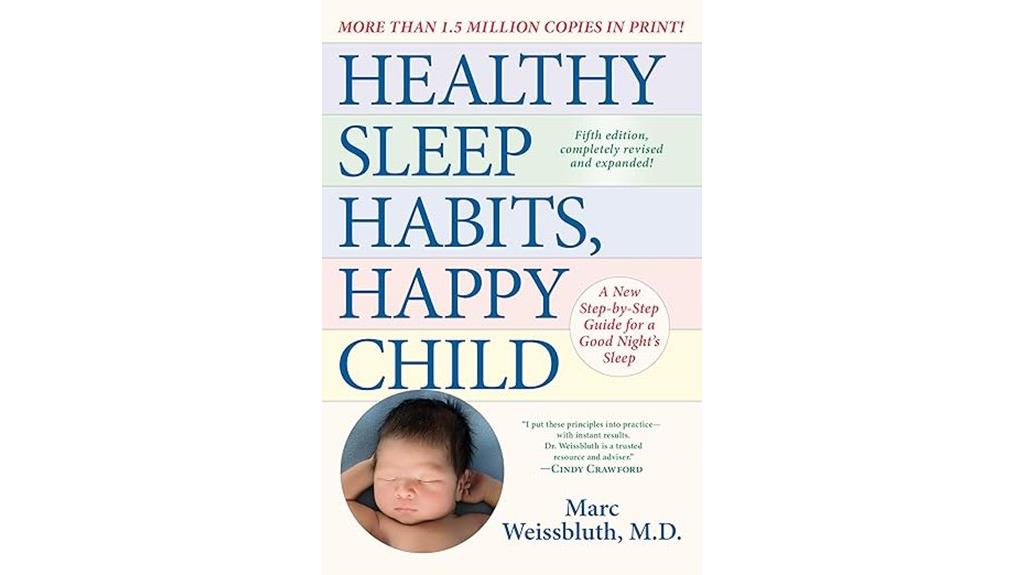
Healthy Sleep Habits, Happy Child, 5th Edition stands out as an ideal resource for parents and caregivers seeking a flexible, evidence-based approach to sleep training. Dr. Marc Weissbluth’s expertise guarantees the guidance is rooted in decades of research, including methods like graduated extinction, emphasizing natural sleep cues and self-soothing. The book’s adaptable approach respects individual family needs, allowing you to choose from multiple strategies without rigidity. Practical tips help establish routines from birth onward, with many parents seeing results within weeks. Its balanced tone and emphasis on personalization make it a trusted, thorough guide for anyone wanting to improve their child’s sleep habits.
Best For: parents and caregivers seeking an evidence-based, flexible approach to establishing healthy sleep habits for children from birth to early childhood.
Pros:
- Rooted in decades of scientific research, including methods like graduated extinction.
- Offers adaptable strategies that respect individual family circumstances and cultural differences.
- Provides practical, step-by-step guidance to help establish routines and promote self-soothing skills.
Cons:
- Some readers find the book lengthy and occasionally challenging to navigate due to organization.
- The detailed approach may be overwhelming for those seeking quick, straightforward solutions.
- Requires parental commitment and consistency, which can be difficult during busy or stressful periods.
Solve Your Childs Sleep Problems: New, Revised, and Expanded Edition

Parents seeking a practical, evidence-based approach to resolve their child’s sleep issues will find “Solve Your Child’s Sleep Problems: New, Revised, and Expanded Edition” particularly helpful. This book shares real parent experiences with Ferber’s method, highlighting how consistent sleep training can reduce night wakings and improve sleep duration. It offers a gentle, flexible process that teaches children to self-soothe by gradually increasing check intervals. The author explains sleep basics and addresses common challenges like bedtime protests. Many parents report that, despite initial tears, their children sleep longer and more peacefully, transforming family life and fostering healthier sleep habits from an early age.
Best For: parents seeking a practical, evidence-based, and gentle approach to help their child develop healthy sleep habits and reduce night wakings.
Pros:
- Provides real parent experiences and success stories, offering reassurance and motivation.
- Offers a flexible, step-by-step method tailored to different parenting styles and child needs.
- Emphasizes consistency and understanding of infant sleep, promoting long-term healthy sleep patterns.
Cons:
- Initial nights may involve emotional challenges and crying, which can be difficult for parents.
- Requires parental commitment to follow the structured process, which may be demanding.
- Some parents may find the gradual process time-consuming before seeing significant results.
Twelve Hours Sleep by Twelve Weeks Old Book

The “Twelve Hours Sleep by Twelve Weeks Old” book is an ideal choice for caregivers seeking a gentle, straightforward approach to establishing long-lasting sleep routines early on. Many parents have seen impressive results, with children sleeping from 7 pm to 7 am by just nine weeks. The routine is simple, intuitive, and effective, helping families reduce exhaustion and improve mental health. It emphasizes consistent daytime feedings, calming bedtime routines, and gentle adjustments to fit individual needs. Supporters highlight its balanced approach, combining responsiveness with structured sleep training, making it a practical, life-changing resource for creating healthy sleep habits from a young age.
Best For: parents seeking a gentle, effective sleep routine for their infants that promotes long-term healthy sleep habits and reduces parental exhaustion.
Pros:
- Simple, intuitive, and easy to implement, making it accessible for busy families
- Produces consistent 12-hour sleep nights from as early as 9 weeks old
- Balances responsiveness with gentle sleep training, supporting attachment and bonding
Cons:
- May require adjustments based on individual baby needs, which can be challenging for some parents
- Critics sometimes misunderstand the method, confusing it with cry-it-out or neglecting attachment principles
- Might not suit families with highly irregular schedules or those unable to strictly follow the routine
Naomi Learns the Importance of Sleep for Kids and Parents

If you’re looking for a gentle, engaging way to teach young children why sleep matters, Naomi Learns the Importance of Sleep for Kids and Parents is an excellent choice. I love how it uses a cute story to explain why everyone, including animals, needs sleep. The colorful illustrations and relatable characters make complex ideas simple and fun for children. It also helps kids understand what happens without enough rest, promoting healthy routines. I’ve found it especially useful for addressing bedtime fears and encouraging positive habits. This book is a great tool for parents, teachers, and caregivers to make bedtime a calm, educational, and enjoyable experience.
Best For: parents, teachers, and caregivers seeking an engaging, educational tool to teach young children about the importance of sleep and healthy bedtime routines.
Pros:
- Uses colorful illustrations and relatable characters to simplify complex sleep concepts for children.
- Supports addressing bedtime fears and promoting positive sleep habits in a gentle, respectful manner.
- Suitable for a wide age range, making it a versatile resource for repeated bedtime routines and educational settings.
Cons:
- May require adult guidance to fully explain some sleep concepts to very young children.
- As a picture book, it may not be comprehensive enough for older children seeking in-depth information.
- Limited focus on technological influences on sleep, which might necessitate supplementary materials for modern technology concerns.
Potty Training in 3 Days Book
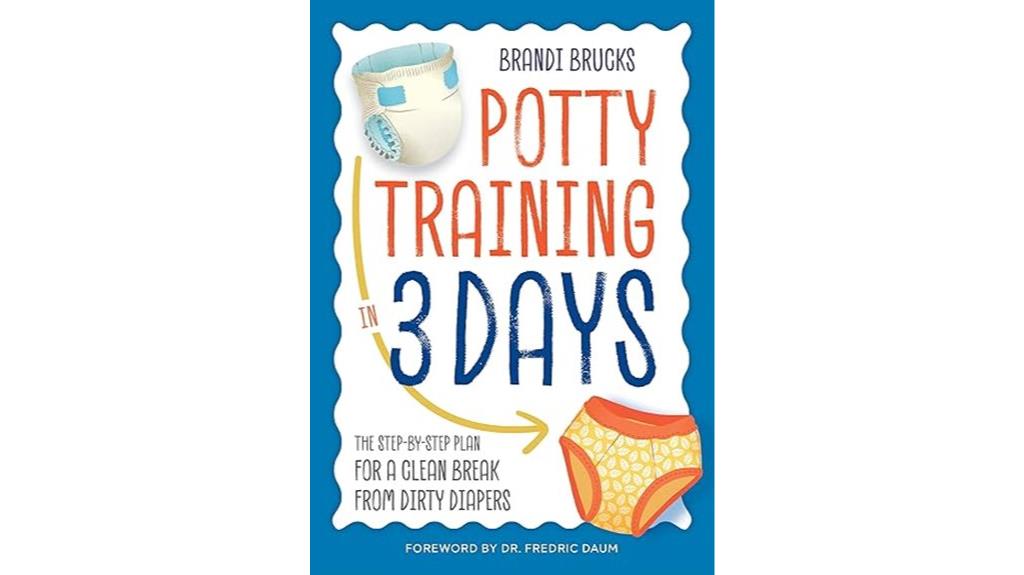
“Potty Training in 3 Days” stands out as an ideal choice for busy parents seeking quick, straightforward results without extensive preparation. I found it to be concise, with clear instructions that many parents report successfully completing in just a few days. The method’s structure—organized into before, during, and after phases—makes it easy to follow and adapt. I appreciated the emphasis on positive reinforcement and routines, which help reduce accidents and tantrums. While some may need to modify the approach for their child’s needs, most see quick, reliable progress, making it a highly effective, time-efficient solution for potty training.
Best For: busy parents seeking a quick, straightforward, and effective potty training method that can be completed within a few days with minimal preparation.
Pros:
- Concise, clear instructions that are easy to follow.
- Highly effective with many parents reporting successful potty training in just a few days.
- Emphasizes positive reinforcement and routine, reducing accidents and tantrums.
Cons:
- May require significant commitment and intensive days of training.
- Some details, such as managing multiple children or bowel training, are missing.
- Certain rewards suggested, like candy, may not be appropriate or desirable for all children.
Precious Little Sleep: The Complete Baby Sleep Guide for Modern Parents

Are you a parent seeking practical, gentle guidance to improve your baby’s sleep while feeling supported and understood? “Precious Little Sleep” offers thorough advice from birth to age 5, addressing common challenges like self-soothing, naps, and regressions. I love its relatable, humorous tone, making complex topics engaging. The strategies help reduce crying, extend sleep, and foster independence. Many parents see real results—faster bedtime, fewer night wakings, and better nap routines—by following step-by-step plans. It also emphasizes flexible methods, including gentle techniques and minimal crying, so you can choose what feels right for your family.
Best For: parents of infants and toddlers seeking gentle, evidence-based strategies to improve sleep, reduce crying, and foster independent sleep habits with practical, relatable guidance.
Pros:
- Offers comprehensive, step-by-step plans tailored to various sleep challenges from birth to age 5
- Uses a relatable, humorous tone that makes complex sleep topics engaging and less stressful
- Emphasizes flexible, gentle methods allowing parents to choose approaches aligned with their values and comfort levels
Cons:
- Not a quick fix; requires consistent effort and patience to see significant results
- Some parents may prefer more strict or traditional cry-it-out methods, which are only minimally discussed
- The detailed guidance may be overwhelming for very new or overwhelmed parents seeking brief solutions
Sleep Like a Tiger Book
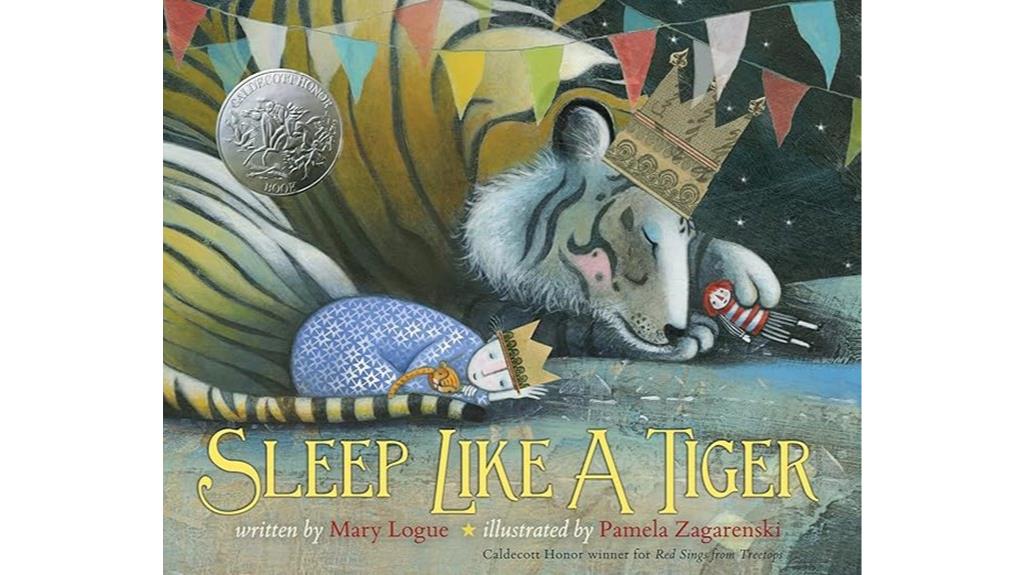
“Sleep Like a Tiger” stands out as an ideal choice for parents seeking a calming bedtime story that appeals to children with vivid imaginations or difficulty settling down. This Caldecott Honor-winning book, with stunning illustrations by Pamela Zagarenski, gently guides kids through a soothing bedtime routine. The story features a girl who questions if everything sleeps, and her parents help her see that animals and nature do rest, including a majestic tiger. The colorful, magical artwork creates a dreamy atmosphere that encourages relaxation. Many parents find it helps their children settle quickly and drift off peacefully, making it a treasured part of bedtime routines.
Best For: parents and caregivers seeking a calming, visually engaging bedtime story that encourages relaxation for children with active imaginations or difficulty settling down.
Pros:
- Beautiful, colorful illustrations that create a dreamy, magical atmosphere.
- Gentle storytelling that helps children transition smoothly to sleep.
- Highly praised for its calming effect and positive portrayal of imagination.
Cons:
- The Kindle version may have some limitations in page size and tactile experience.
- Some children may find the detailed illustrations overwhelming if they prefer simpler images.
- The story’s focus on imagination may not appeal to children who prefer more straightforward bedtime routines.
Become Your Childs Sleep Coach

If you’re a parent who feels overwhelmed by bedtime battles and unsure how to guide your child toward independent sleep, “Become Your Child’s Sleep Coach” is the perfect resource. Many parents report quick, noticeable improvements—like a 4-year-old sleeping through the night after just two days. The book offers simple, science-based strategies such as the “5 B’s” and the Bedtime Basket, making routines manageable and effective. Dr. Schneeberg’s gentle, practical advice fosters confidence and independence in children. Parents love its clear instructions and relatable stories, transforming bedtime struggles into calm, peaceful routines that benefit the whole family.
Best For: Parents seeking practical, gentle, and science-based solutions to help their children develop healthy sleep habits and resolve bedtime struggles.
Pros:
- Offers clear, easy-to-follow strategies grounded in sleep science
- Provides relatable success stories that motivate and inspire confidence
- Introduces innovative, child-friendly tools like the Bedtime Basket to make routines engaging
Cons:
- May require consistent effort and patience to see long-term results
- Some strategies might need adaptation for children with specific developmental or behavioral needs
- As a book, it may lack personalized guidance for complex or severe sleep issues
Stress-Free Sleep Training for Babies

Stress-Free Sleep Training for Babies is especially helpful for exhausted parents seeking gentle, practical methods to improve their infant’s sleep. I’ve found that these techniques are straightforward, adaptable, and focus on establishing consistent routines without causing stress. Many parents see quick results—calmer bedtimes, longer stretches of sleep, and babies sleeping through the night. The strategies are rooted in science and consider developmental stages, teething, travel, and other challenges. Best of all, they promote emotional well-being for both baby and parent, making sleep training feel achievable, supportive, and less overwhelming. This approach truly restores sanity and helps everyone enjoy more restful nights.
Best For: exhausted parents and caregivers seeking gentle, practical, and science-backed sleep training methods to help their infants establish healthy sleep routines with minimal stress.
Pros:
- Gentle, adaptable strategies that focus on emotional well-being for both baby and parent
- Quick and noticeable results, such as calmer bedtimes and longer sleep stretches
- Supports diverse challenges like teething, travel, and developmental regressions with practical solutions
Cons:
- May require consistent implementation over several days to see full benefits
- Some parents might prefer more structured or traditional sleep training methods
- The approach relies on parents’ commitment to routines, which can be challenging during busy or unpredictable schedules
The Sleepeasy Solution Guide for Parents of Young Children

The Sleepeasy Solution is an excellent choice for parents of young children who are ready to address persistent sleep challenges with a structured, gentle approach. I’ve seen many parents struggle with frequent night wakings, short naps, and exhaustion, and this book offers practical, evidence-based strategies to help. It encourages gradual, consistent sleep training that involves some crying but ultimately teaches children to self-soothe. Parents report quick improvements—longer stretches of sleep and happier mornings. While initial discomfort is common, the long-term benefits include better sleep for both baby and parent, along with increased patience and energy.
Best For: Parents of young children seeking a gentle, structured approach to overcoming sleep challenges and establishing healthy sleep habits.
Pros:
- Evidence-based strategies leading to quicker improvements in sleep patterns
- Emphasizes gradual, gentle methods that minimize distress for the child
- Offers clear, compassionate guidance suitable for overwhelmed parents
Cons:
- May involve some crying, which could be difficult for sensitive parents
- Requires consistency and patience, potentially taking time to see full results
- Less suitable for parents seeking an entirely cry-free, attachment-based approach
The Sleep Lady’s Good Night Sleep Tight Book

The Sleep Lady’s Good Night Sleep Tight Book stands out as an ideal choice for parents seeking a gentle, hands-on approach to sleep training. I appreciated its practical guidance on establishing routines, understanding sleep needs, and responding calmly to night wakings. The method involves staying nearby, comforting without picking up, and gradually increasing distance, which many parents find effective. Despite initial night crying, children adapt quickly, and sleep improves within days or weeks. I found the focus on putting babies drowsy but awake helped foster independent sleep skills. Overall, this book offers a compassionate and effective way to help your little one sleep through the night.
Best For: parents seeking a gentle, practical, and compassionate approach to helping their baby develop healthy sleep habits.
Pros:
- Provides straightforward, non-judgmental guidance on establishing routines and sleep needs
- Emphasizes comforting without crying it out, making it suitable for sensitive parents
- Encourages consistent, gradual sleep training that leads to quicker, lasting improvements
Cons:
- Initial night crying can be intense and may require patience and reassurance
- Some parents may find the gradual approach too slow for their preferences
- Requires ongoing consistency and commitment, which can be challenging for busy or overwhelmed caregivers
Healthy Sleep Habits, Happy Twins: A Step-by-Step Program for Sleep-Training Your Multiples
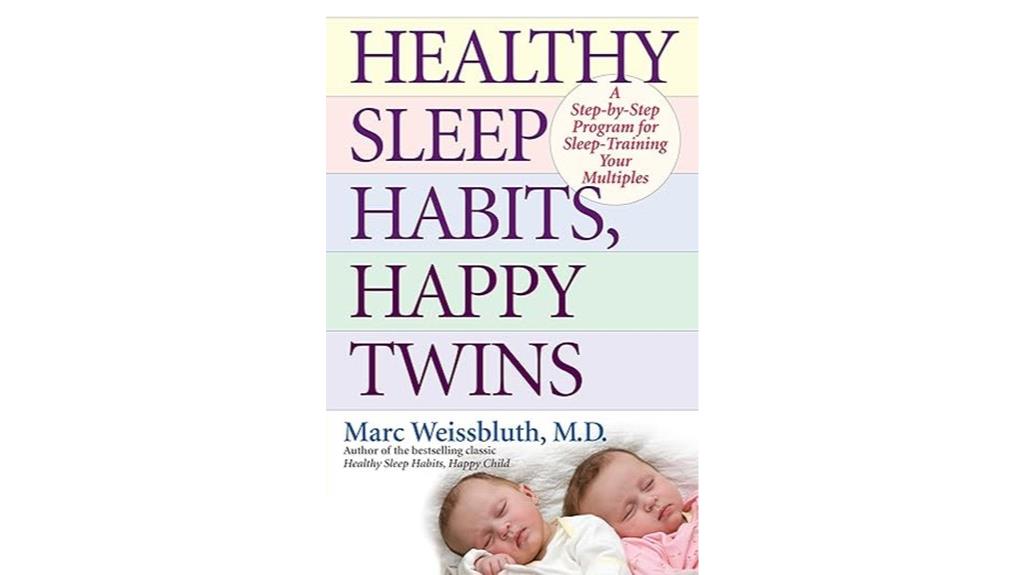
Parents of twins who are struggling to establish consistent sleep routines will find “Healthy Sleep Habits, Happy Twins” an invaluable resource. This step-by-step program offers practical, research-backed advice tailored specifically for multiples. I love how it emphasizes gentle, consistent methods that help babies fall asleep independently and stay asleep longer. The book covers routines, sleep cues, and safe sharing strategies, like using barriers in cribs. Many parents report their twins sleeping through the night by just a few weeks, with smoother daytime naps. It’s a reassuring guide that boosts confidence and provides clear, compassionate instructions for managing sleep challenges with twins.
Best For: Parents of twins seeking gentle, research-backed strategies to establish consistent sleep routines and improve their babies’ sleep patterns.
Pros:
- Provides a tailored, step-by-step program specifically for multiples, addressing unique twin sleep challenges.
- Emphasizes gentle, effective methods that promote independent sleep without harsh cry-it-out techniques.
- Offers practical tips on routines, sleep cues, safe sharing strategies, and using barriers to reduce SIDS risk.
Cons:
- May require a commitment to consistency and routine adjustments, which can be demanding for some parents.
- Some parents might prefer more structured or specific techniques over a flexible, philosophy-based approach.
- The focus on twins means the advice might be less directly applicable to parents of singletons seeking similar guidance.
Factors to Consider When Choosing Child Sleep Training Books
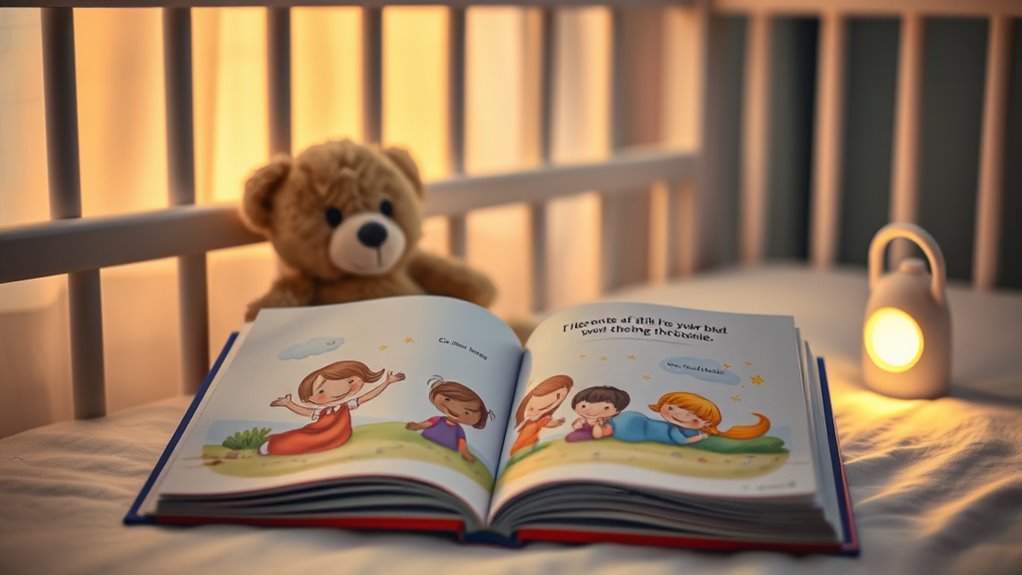
When selecting a sleep training book, I consider whether the advice suits my child’s age and my parenting style. I look for methods backed by research and that are easy to follow, while also offering emotional support. These factors help me choose a resource that’s practical and aligns with my family’s needs.
Age Appropriateness
How do you choose a sleep training book that truly fits your child’s developmental stage? First, verify the guidance matches your child’s age—whether newborn, infant, toddler, or preschool. Different ages face unique sleep challenges, so look for books that address these specific issues, like establishing routines for newborns or shifting to independent sleep for older kids. Flexibility is key; select a book that offers methods suitable for your child’s ability to self-soothe, communicate, and follow routines. Also, check if the content aligns with your child’s typical sleep patterns and needs. In conclusion, consider whether the tone and approach match your parenting style—whether gentle or structured—to ensure the strategies feel practical and manageable for your child’s age.
Parenting Style Compatibility
Choosing a sleep training book that aligns with your parenting style can make all the difference in successfully helping your child develop healthy sleep habits. If you value attachment and responsiveness, you’ll likely prefer books that focus on gentle reassurance and gradual techniques, rather than strict methods. Conversely, if your approach is more authoritative or structured, you might lean toward books that emphasize routine, consistency, and controlled checks. Recognizing your parenting values helps you choose strategies you’re comfortable with, increasing your confidence and consistency. When your chosen book matches your discipline style, you’re more likely to follow through and see positive results. Compatibility between your parenting philosophy and the method is key to creating a positive sleep environment for your little one.
Evidence-Based Methods
Are you wondering how to identify sleep training books backed by solid scientific evidence? Look for books that rely on scientific research and clinical studies, ensuring their methods are rooted in proven principles of child sleep biology. These books often feature techniques like graduated extinction, fading, or sleep associations supported by pediatric sleep experts and empirical data. They emphasize safe practices, avoiding harmful methods such as prolonged crying or neglect, and promote gentle, developmentally appropriate strategies. Good evidence-based books clearly explain sleep mechanisms, including wake windows and circadian rhythms, based on scientific understanding of infant and child sleep needs. Their effectiveness is often validated through parental success stories and clinical trials showing improvements in sleep quality, duration, and family well-being.
Ease of Use
When selecting a child sleep training book, practicality and ease of use are key factors that can make a significant difference in your experience. A user-friendly book offers clear, step-by-step instructions that guide you through each phase, making the process manageable. Visual aids, charts, or summaries at the end of chapters can help you quickly reference key points and implement routines confidently. The language should be straightforward and free of jargon, so you don’t feel overwhelmed or confused. Practical tips and troubleshooting advice presented in bullet points or Q&A sections make it easier to handle common challenges. In conclusion, a well-structured book with logical progression and manageable sections helps you seamlessly integrate sleep routines into your busy daily life.
Emotional Support Level
Have you ever felt overwhelmed by guilt or exhaustion while trying to help your child sleep? You’re not alone. When choosing a sleep training book, I look for one that offers empathetic language, reassuring me without judgment. It’s essential that the book acknowledges parental exhaustion, guilt, and anxiety, providing encouragement and practical reassurance. I also appreciate stories or testimonials that show understanding and validate how I feel during this challenging time. Gentle methods are a must—books that avoid harsh or strict approaches help create a positive emotional environment for both parent and child. Additionally, I value resources that emphasize self-care and emotional well-being as part of the process, reminding me that caring for myself is just as important as caring for my child’s sleep.
Special Needs Adaptation
Choosing a sleep training book for a child with special needs requires careful attention to how well the approach can be adapted to your child’s unique developmental and behavioral profile. I recommend selecting resources that address specific challenges like sensory processing issues, developmental delays, or medical conditions affecting sleep. Opt for books that emphasize gentle, flexible methods rather than rigid routines, which can better accommodate varying sensory sensitivities and emotional needs. It’s also important to find guides that offer advice on modifying strategies for children who need additional support or alternative sleep routines. Finally, seek out books authored or reviewed by professionals with expertise in pediatric special needs to ensure the guidance is safe, effective, and tailored to your child’s specific circumstances.
Frequently Asked Questions
How Do I Choose the Best Sleep Training Book for My Child’s Age?
When choosing a sleep training book for my child’s age, I first consider their developmental stage. For infants, I look for gentle, responsive methods; for toddlers, I want strategies that respect their independence. I also check reviews and author credentials to guarantee the advice is reliable. Matching the approach to my child’s specific needs helps me feel confident that the book will support us through this journey.
Are There Books Suitable for Parents With Multiples or Twins?
You’re asking if there are sleep training books suitable for parents with multiples or twins. I’ve found that many books focus on single children, but some, like “Healthy Sleep Habits, Happy Child,” offer advice applicable to multiples. I recommend looking for books that address sleep routines for more than one child, so you can adapt strategies to your family’s unique needs. It’s all about finding what works best for you.
Can These Books Address Sleep Issues Caused by Medical or Behavioral Problems?
You’d think a good sleep book could fix everything, right? Well, not quite. While these books are fantastic for general sleep tips, they often don’t address sleep issues caused by medical or behavioral problems. I’ve found that if your little one’s struggles stem from health issues, consulting a healthcare professional is essential. Books can guide, but they’re no substitute for personalized advice when it’s critical.
Do These Books Include Personalized Sleep Plans or Routines?
Many sleep training books focus on general routines and tips, but some do include personalized sleep plans tailored to your child’s age and needs. I’ve found that books with customizable routines help me adapt strategies for my little one’s unique sleep patterns. It’s worth checking the contents or reviews to find one that offers flexible, step-by-step plans that you can modify, making the process feel more manageable and effective.
How Long Does It Typically Take to See Results Using These Sleep Training Methods?
When you start sleep training, I find it usually takes about a week or two to see noticeable results, though it varies. Regular routines and consistency are key—some children adjust faster than others. I recommend sticking with the method you choose and giving it time. Patience is essential, and before long, you’ll both be enjoying more restful nights. Trust the process, and you’ll get there.
Conclusion
Think of these books as your guiding stars in the night sky, illuminating your path to peaceful sleep for your little one. Each one offers a beacon of hope, clarity, and reassurance amid the darkness of sleep struggles. With patience and the right guidance, you’ll find your way to calm, restful nights. Remember, every star contributes to the night’s beauty—so trust these resources to help your family shine brightly in sleep harmony.
